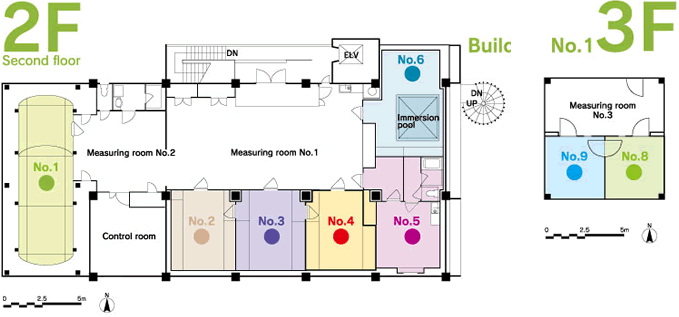RESEARCH CENTER FOR HUMAN ENVIRONMENTAL ADAPTATION
The Research Center for Human Environmental Adaptation at the Faculty of Design, Kyushu University, Fukuoka, Japan, was originally established in 1971 by Kyushu Institute of Design, and completely reconstructed in 2001. It is situated in a two-story 744 m2 building which contains 9 chambers controlling air pressure, air temperature, air humidity, air velocity, illumination and water pressure. The main purpose of the center is to ascertain the conditions necessary for healthy and comfortable living environments by investigating human environmental adaptability. In the expanded university, which leads international academic research, the center now has more of a role to play in the understanding of human beings.
FACILITIES
��Click each room for more details.


PURPOSE
Human beings gradually developed living spaces by overcoming hostile natural environments, and are creating comfortable artificial environments through advances in science and technology. We are now able to control many environmental factors, such as temperature, air quality, sound, illumination and air pressure. Moreover, we are expanding our activity to the oceans and to space, places which 50 years ago human beings could only dream of inhabiting. There are, however, many reports of health hazards in the artificial environments in which people spend 90% of their time in modern society. For example, an increase in artificial illumination results in shift work, which is contrary to our biological rhythms. Overcooling by air conditioning systems causes new health complaints in buildings. There are even concerns about the possibility of the deterioration of human adaptability, which has envolved over hundreds of thousands of years. The Research Center for Human Environmental Adaptation was established to solve these problems scientifically. It is situated in a two-story 744 m2 building which includes machinery rooms, an observation room, and a climatic chamber on the first floor, and 6 climatic chambers, two measuring rooms and a control room on the second floor. There are 2 more climatic chambers in another building.The research center was originally established in 1971, and was completely reconstructed in 2001. In the Section of Ergonomics, which is the main user of this center, there are at present(2008) 7 faculty staff, 5 postdoctoral, 16 Doctoral and 21 Master Course students. The main purpose of the center is to clarify the conditions necessary for healthy and comfortable living environments by investigating human environmental adaptability. The research center is designed for both short and long-term experiments. Some of the chambers have a bathroom, toilet and kitchen, which enable subjects to stay for more than a week. The following kinds of research are planned in the Center: Physiological evaluation of new 21st century living environments, i.e. sea beds, very high-rise buildings and ultra-deep underground structures. The effects of a living environment�fs temperature, air pressure, illumination, light color temperature and Oxygen concentration on human physiological and subjective responses. The effects of living environments and life-style on sleep. The development of air-conditioning systems, beds, bathrooms and sanitary systems for the elderly. The RESEARCH CENTER FOR HUMAN ENVIRONMENTAL ADAPTATION is a leading international research center in its field.
PERFORMANCE ABILITY OF THE CLIMATIC CHAMBERS






